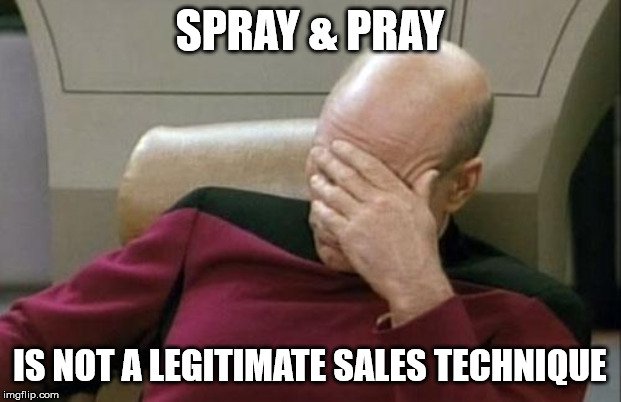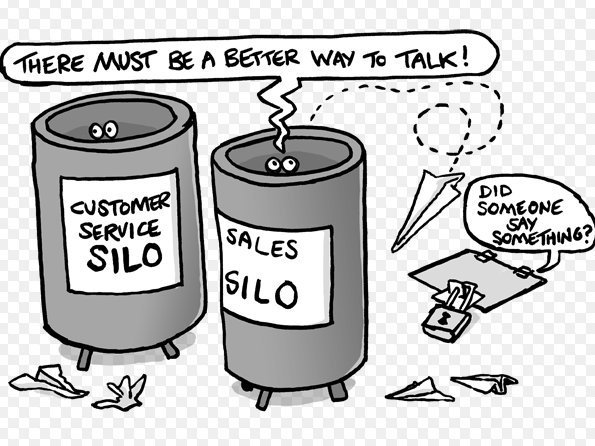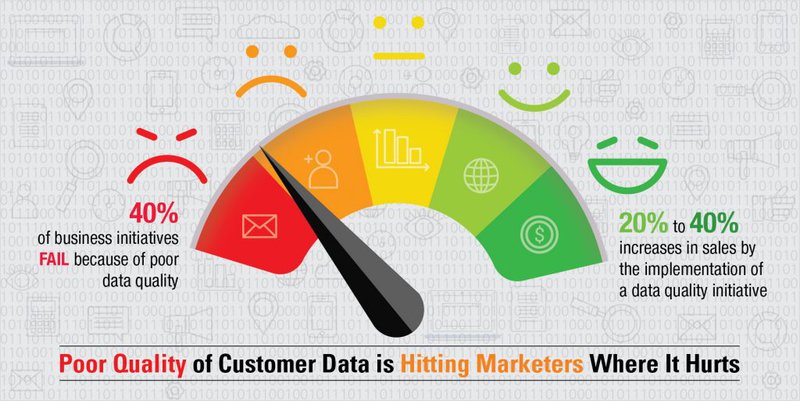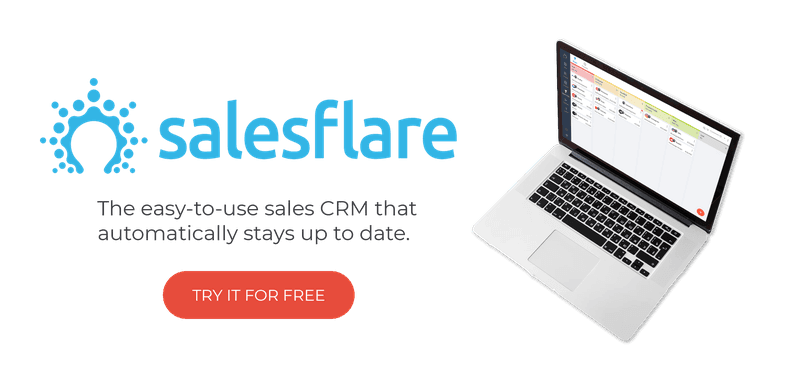Why You Need A Data-Driven Sales Team—And How To Build One
Een gastblog door Josh Brown (Marketing bij Helpjuice)

We’re just gonna come right out and say it:
Verkopen is een spel van getallen.
Hold on, hold on… we don’t mean that in the traditional sense.
(In fact, we’d argue that a wide net, “spray and pray” approach to sales definitely isn’t the way to go by today’s standards.)

What we mean is that, if your goal is to maximize your sales productivity, your first step should be to look to the numbers. This means the myriad data available to your team regarding your customers, your team’s performance, and more.
Je volgende stap: duik er halsoverkop in.
1. Het datagestuurde verkoopteam definiëren
Before we get too far ahead of ourselves, we need to nail down exactly what it means for a sales team to be “data-driven.”
Let’s start with a more overarching (and admittedly vague) definition:
Een datagestuurd verkoopteam is een team dat de analyse en het gebruik van gegevens heeft geïntegreerd in alle verkoopgerelateerde processen en activiteiten.
As you might imagine, organizations that have become truly data-driven typically outperform their competition—by a pretty wide margin, too. High-performing sales teams are 3.5 times more likely to have used a data-driven approach than their under-performing counterparts. And companies that have “injected” data into their daily operations are 5% more productive and 6% more profitable than their competition.
Now, there are a few key words we want to call attention to: “integrated” and “injected.” That is, truly data-driven sales teams don’t just “use” data: they find ways to “integrate” and “inject” the data into their daily activities through data transformation. Essentially they put data at the center of everything they do. For such teams, data and hard evidence is never an afterthought. In fact, it’s more often the catalyst that leads the team to make a certain decision or take a specific action.
In this article, we’ll discuss everything that needs to happen for your sales team to become truly data-driven in its everyday operations.
Before we dig in, though, let’s talk about some of the more specific benefits of becoming data-driven.
2. Drie belangrijke voordelen van datagestuurd zijn
Zoals we net al zeiden, zijn datagestuurde verkoopteams productiever en winstgevender dan hun slecht presterende concurrenten.
Maar dit zijn eigenlijk de bijproducten van datagestuurd worden. Je wordt productiever en efficiënter, niet door alleen maar datagestuurd te worden, maar door wat je met datagestuurd worden kunt doen.

Let’s dig a bit deeper into that, shall we?
1. Maakt gestandaardiseerde (en geoptimaliseerde) verkoopprocessen mogelijk
Simpel gezegd:
Most sales teams and organizations end up wasting a ton of time, money, and energy, because they haven’t truly optimized their various processes.
For starters, sales teams waste a lot of time doing “legwork” rather than actually being productive.

As the image above shows, nearly one-fifth of the average salesperson’s day is spent searching for pertinent information. Not “putting collected data to use”; just searching for it in the first place.
As we’ll get to a bit later on, one of the first steps to becoming data-driven is creating a central data hub that your sales team (and other employees) can access as needed. The easier it is to find the information they need, the quicker your sales team will be able to get to work.
Another issue that comes along with not being data-driven is that you run the risk of wasting resources without even realizing you’re doing so.
Altify ontdekte bijvoorbeeld dat een verbazingwekkende $591 miljard verloren gaat in de VS (en $1,4 triljoen wereldwijd) door verkoopteams die minder dan uitstekende leads najagen die uiteindelijk nergens toe leiden. Dit komt overeen met gegevens die zijn verzameld door MarketingSherpa waaruit blijkt dat slechts 27% van de leads die worden doorgegeven aan verkoop ook daadwerkelijk gekwalificeerde leads zijn.
In such cases, it’s clear that the marketing team’s qualification process differs wildly from the sales team’s processes. Chances are, the data each team is looking at throughout these processes differs just as wildly. Because of this discrepancy, it would simply be impossible for each team to get on the same page moving forward.
However, by centralizing all incoming data (for example, through the use of a CRM)—and collaborating to determine which pieces of information are most vital to a given process—your marketing and sales (and other) teams can begin creating a more systematic approach to creating a funnel that sells.
2. Stelt je verkoopteam in staat zich te personaliseren
Aan de klantgerichte kant van de zaak wordt het veel gemakkelijker voor uw verkoopteam om contact te leggen met prospects en klanten op een meer individueel niveau.
Zoals je waarschijnlijk weet, is er tegenwoordig steeds meer vraag naar deze personalisatie. Volgens gegevens verzameld door Evergage:
- 63% van de consumenten heeft een hoge pet op van merken die gepersonaliseerde en relevante aanbiedingen en content bieden
- 77% van de consumenten kiest, beveelt aan en betaalt meer voor merken die een meer persoonlijke service bieden
- 78% alleen ingaan op aanbiedingen die zijn afgestemd op hun behoeften, op basis van hun geschiedenis met een merk
For our purposes, here’s the big one: Most consumers are perfectly fine with companies using their private and public data in order to provide them a more personalized experience.
Needless to say, the more data you collect on your prospects and customers—and the more focused you become on what this data actually “means”—the easier it will be for your sales team to engage with them and nurture them toward conversion.
Along with this, a comprehensive collection and understanding of data can take the guesswork out of approaching relatively unknown prospects. For example, in recognizing similarities between a new prospect and your most-valuable customer segment (in terms of persona, behavior, etc.), you’d know exactly what to do at a given point in time in order to get them to convert.
For a prime example of all this in action, look no further than easyJet’s 20th anniversary campaign. Essentially, the travel company used individual customer data, along with automation software, to develop a dynamic email campaign showcasing each customer’s experience with their brand.

The results were nothing short of outstanding. First of all, the team created and sent out over twelve million unique emails—and saw a massive 100% increase in open rates throughout the campaign. What’s more, the campaign earned a 25% higher click-through rate than easyJet’s typical average.
So…yeah. If your goal is to provide a more personalized experience to your audience, your first step should be to go to the data.
3. Ontdekt belangrijke kansen
Eerder bespraken we hoe datagestuurdheid je in staat stelt om doodlopende leads en dergelijke te herkennen en te vermijden.
The other side of all this is that you’ll in turn uncover and recognize a treasure trove of opportunities you may have otherwise overlooked.
Nogmaals, het komt allemaal neer op personalisatie en precies aanbieden wat een specifieke consument wil op juist het juiste moment. Een paar voorbeelden:
- Precies weten welk product of welke producten een nieuwe prospect waardevol zou vinden
- Upsell- en cross-sell-aanbiedingen aanbieden aan klanten op basis van huidige en eerdere aankopen
- Tijdige herinneringen en verdere aanbiedingen sturen naar terugkerende klanten in de aanloop naar hun gemiddelde aankoopmoment
In each of these scenarios, data is at the center of the sales team’s ability to follow through.
Zonder een enorme focus op gegevens zou het team misschien:
- Lose sales by showcasing products that aren’t best-fit for specific prospects
- Extra inkomsten mislopen door kansen voor upsell en cross-sell over het hoofd te zien
- Het risico lopen terugkerende klanten te verliezen door hun terugkeer aan het toeval over te laten
Het spreekt voor zich dat je deze scenario's zoveel mogelijk wilt vermijden. Een scherpe focus op gegevens zal je verkoopteam alle kansen duidelijk maken.
Als het erop aankomt, is meer datagestuurd worden gewoon goed voor het bedrijf:
- Gestroomlijnde processen zorgen voor maximale efficiëntie en optimaal gebruik van hulpbronnen
- Gepersonaliseerde verbintenissen leiden tot meer conversies
- Verbeterde zichtbaarheid van gegevens werpt licht op belangrijke verkoopkansen
Nu we dit allemaal weten, wordt de vraag:
Hoe worden we meer datagestuurd binnen onze eigen organisaties?
3. Een datagestuurd verkoopteam samenstellen
As we made clear earlier, there’s a huge difference between merely collecting and using data in a more surface-level manner, and truly integrating data into your overall operations and processes.
Here, we’ll dive into all that goes into creating a sales team (and overall organization) that is truly driven by data.
Without further ado, let’s dive in.
1. Faciliteer een culturele en organisatorische verschuiving
If your team isn’t on board with the shift, it’s simply not going to happen.
Er zijn een aantal dingen die je moet doen om deze buy-in onder je verkoopteam te genereren.
First, it’s essential that you frame this discussion in terms of what it means for them. As we talked about earlier, this is all about becoming more productive and efficient—and overall more successful in their efforts as salespeople.
On that same token, it’s also important that you explain why becoming more data-driven will allow your sales team to become more successful. Tap into some of the frustrations your team likely has revolving around data (or lack thereof), such as miscommunication, down time, and wasted opportunities—and show your sales team exactly how a focus on data will help alleviate these pain points moving forward.
Finally, in terms of cultural shift, you’ll want your team to begin operating with a “data first” mindset. That is, your sales team should begin looking to data to inform the next decision they make—not to retroactively rationalize decisions that have already been made. While this might sound like mere semantics, the reality is that taking a “data first” approach to sales will all but ensure your sales team focuses on making improvements that actually matter.
Now, in addition to the cultural and mental shift that must occur throughout your sales team, you’ll also likely need to facilitate a shift in how your sales team interacts with your organization’s other departments.

First, you need to be sure cross-team communication and collaboration is possible, let alone practical. Obviously, if it’s too difficult—or actually impossible—for your sales team to communicate with your marketing and other departments, it’s just not going to happen.
Once cross-team communication is possible throughout your organization, you need to ensure it actually happens—and is done so correctly. Basically, this means systematizing what data and information certain teams are responsible for communicating to whom at certain points in the sales funnel.
We’ll get more into this in a bit, but for now just know that the better your sales and marketing teams communicate, the more aligned they’ll become. By focusing on and communicating the data and information that really makes a difference, each team will gain a more consistent understanding of what a “qualified lead” really is. In turn, your sales team will be able to nurture these high-probability candidates through the sales funnel with relative ease.

Maar, nogmaals, niets van dit alles is mogelijk tenzij je de verschuiving in je hele organisatie faciliteert.
2. Define and Prioritize “Quality” Data
We’ve danced around this topic throughout this article, but let’s lay it right out there:
Part of being truly data-driven is knowing that some data is simply more valuable than other pieces of information. In that same vein, it’s also in knowing how to discern a so-called “vanity metric” from a metric that truly matters to your company’s bottom line in some way or another.
Of course, if you don’t have a specific definition or criteria for what your team considers “quality data,” you’re going to run into problems pretty quickly. As we alluded to earlier, if your marketing team is passing through leads based on one set of data, and your sales team is looking at something completely different, there’s little chance that those prospects will end up converting.

Zoals hierboven is aangetoond, kan een gebrek aan aandacht voor gegevenskwaliteit de reden zijn waarom een bedrijf voorgoed de deuren sluit. Aan de andere kant ervaren bedrijven die zich wel richten op gegevenskwaliteit vaak een grote omzetgroei.
Voor ons doel zijn er twee overkoepelende soorten gegevens waar we ons hier op moeten richten:
- Klantgerelateerde gegevens
- Prestatiegegevens van werknemers en teams
In terms of customer-related data, we’re talking about segmentation and persona information, combined with a specific customer’s individual history with your company.
To be sure, each piece of information you collect on a given customer is important in some way or another. However, it’s important to explicitly define and prioritize specific data to be used at given points in time for sales-related purposes. Not only will it ensure consistency between your marketing and sales teams, but it will also ensure your sales team has exactly what they need to make an informed decision regarding a specific prospect.
In defining these data points, you’ll want to consider a variety of questions such as:
- Welke gegevens verzamelt het marketingteam dat het verkoopteam moet weten?
- Aan welke informatie moet je de meeste waarde hechten bij het scoren van leads?
- How will having x piece of data affect the sales team’s approach?
We’ve said it before:
Hoe beter uw verschillende teams op elkaar zijn afgestemd wat betreft datagedrevenheid, hoe productiever uw verkoopteam kan zijn.
Speaking of that, the other side of defining “quality” data is in looking at the performance of your sales team overall.
Again, our focus here is on the metrics that truly make a difference to the overall productivity and efficiency of your business. More specifically, we’re looking at data points such as:
- Leads omzetten: Obviously, a salesperson’s job is to make sales. If their overall conversion rate is relatively low, you’ll need to dig deeper to determine where the leak occurs, and what the problem actually is.
- Lengte verkoopcyclus: Simpel gezegd: hoe langer je team erover doet om een verkoop te doen, hoe minder tijd ze hebben om zich te concentreren op het maken van andere sales. Similarly to the above, it’s important to get granular in determining what, exactly, needs to be improved to shorten an all-too-lengthy sales cycle.
- Gemiddelde bestelwaarde: The probably goes without saying, but the more your sales team can sell at a single time, the better off your business will be. Digging into changes in AOV and other related metrics will give you better insight into what, specifically, presses your target customers’ buying button.
Again, this isn’t to say these are the only metrics that matter; far from it, in fact. The point is that you need to define the metrics that tell a more overarching story about a certain aspect of your business, then dig deeper to decipher the details. The more granular you get, the more information you’ll have on-hand to make improvements in the future.
Je kunt precies deze statistieken en meer bijhouden met behulp van een CRM zoals Salesflare. Bekijk onze producttour voor meer informatie.
3. Tools en technologie integreren
Hey, you didn’t think you’d be tracking all this data by hand, did you?
Alle gekheid op een stokje, technologie is in wezen de kern van je vermogen om al deze informatie te verzamelen en te gebruiken.
While there are, of course, a plethora of tools and software to choose from to serve your data-driven needs, you’ll at least want to invest in the following:
- Schrapers van klantgegevenszoals Datanyze InsiderHiermee kun je snel en eenvoudig klantgegevens uit verschillende databases verzamelen. Vervolgens kun je de verzamelde lijst analyseren op basis van specifieke criteria voor verder klantonderzoek.
- Software voor klantrelatiebeheer zoals Salesflare make it easy to keep track of customer profiles and track engagements with prospects throughout their personal buyer’s journey. The more information collected and stored within your CRM, the more personalized your sales team’s approach can be.
- Kennisbanken zoals Helpjuice kunt u belangrijke informatie over processen, producten en andere interne gegevens creëren, opslaan en delen. U kunt ook klantgerichte kennisbankenZo kunnen je klanten zich meer betrokken voelen bij je bedrijf en meer waarde uit je producten halen.
- Trackers voor verkoopprestaties zoals Ambition maken het je team gemakkelijk om de effectiviteit van hun verkoopprocessen op zowel macro- als microniveau te beoordelen. Je team kan zich dan richten op het maken van specifieke verbeteringen die hen in staat stellen efficiënter te werken.
- CDPs or DMPs – other software like a CDP or DMP might also be useful to you. These tools will enable your sales team to have a complete 360 view of customers across all the touch points your business has.
The “best” software for your company depends on your company’s current needs, bandwidth, and other such factors. Before you commit to using any one specific tool or service, make sure you’ve found the one that will integrate most seamlessly into your operations, and that will provide the most value in return.
4. Voortdurend verbeteringen aanbrengen
As you can probably tell, shifting toward becoming more data-driven isn’t something that will happen to your sales team overnight.
And, in a sense, it’s not something that ever fully “happens,” at all. That is, there will always be ways for your team to become more data-driven, and to become more efficient and effective in their overall processes, as well.
Het goede nieuws is:
Hoe meer datagestuurd u wordt, hoe gemakkelijker het zal zijn om nog meer datagestuurd te worden.
For one thing, once your sales team begins to see the positive impact of becoming more data-driven, they’ll inherently want to dive deeper into this “new way” of doing things. Soon enough, your sales team will begin seeing this “new way” will as the normal and natural mode of operating.
Met deze verhoogde buy-in van je verkoopteam wordt het doorvoeren van continue verbeteringen in feite een onderdeel van het totale proces. Een echt datagestuurd verkoopteam begrijpt niet alleen het belang van het injecteren en integreren van gegevens in hun processen, maar begint ook kritisch na te denken over hoe ze dit het beste kunnen doen.
As you look to make improvements, you’ll want to think about the answers to questions such as:
- Hoe heeft het meer gegevensgestuurd worden ons in staat gesteld om te verbeteren op xyzgebied?
- Welke gegevens zijn het meest essentieel of informatief voor het verbeteren van xyz?
- Welke andere gegevens of inzichten kunnen we gebruiken om xyz verder te verbeteren?
Natuurlijk zijn deze vragen slechts aanknopingspunten om je team te helpen dieper in te gaan op een specifiek proces of gebied. Het spreekt voor zich dat je onderzoekslijn sterk zal verschillen afhankelijk van je aandachtsgebied.
Regardless of your focus, though, with data at the heart of your inquiry, you’ll easily be able to dig up the information needed to make your next steps crystal clear.
Een beetje over Josh:
Josh Brown maakt deel uit van het marketingteam van Helpjuice. Helpjuice biedt gebruiksvriendelijke en volledig aanpasbare kennisbanken die vanaf de basis zijn ontworpen om u te helpen uw klantenondersteuning uit te breiden en beter samen te werken met uw team.

We hopen dat je deze post leuk vond. Als je het leuk vond, vertel het dan verder!
👉 Je kunt @salesflare volgen op Twitter, Facebook en LinkedIn.
if(window.strchfSettings === undefined) window.strchfSettings = {}; window.strchfSettings.stats = {url: “https://salesflare.storychief.io/data-driven-sales-team?id=1549749501&type=2”,title: “Why You Need A Data-Driven Sales Team—And How To Build One”,id: “b4bf56dd-9b24-4318-a472-b8522fe85e05”}; (function(d, s, id) { var js, sjs = d.getElementsByTagName(s)[0]; if (d.getElementById(id)) {window.strchf.update(); return;} js = d.createElement(s); js.id = id; js.src = “https://d37oebn0w9ir6a.cloudfront.net/scripts/v0/strchf.js”; js.async = true; sjs.parentNode.insertBefore(js, sjs); }(document, ‘script’, ‘storychief-jssdk’))- Fix It Fast - 3 april 2024
- Bewaar uw e-mails - 21 december 2023
- Trace Any Relationship - 1 december 2023
